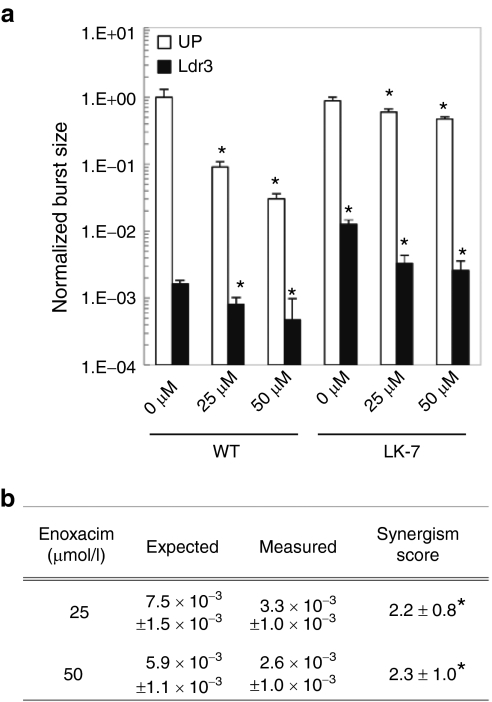Figure 6.
Enoxacin acts synergistically with RNA interference (RNAi) to inhibit a mutant indirectly resistant to Ldr3 alone. (a) Unprotected or Ldr3-protected cells were infected with wild-type (WT) or mutant HIV at a multiplicity of infection (MOI) of 0.005 in the presence of increasing amounts of enoxacin or carrier (dimethyl sulfoxide (DMSO)). Total viral burst sizes were calculated as previously described over 10 days and normalized to the burst size of WT virus in unprotected cells. Experiments were conducted in biological triplicate, and error bars represent 1 SD. *A significantly different burst size compared to the same virus and cell type without enoxacin (0 µmol/l) (P < 0.05). (b) Expected burst sizes for mutant LK-7 in the presence of enoxacin and the Ldr3 short hairpin RNA (shRNA) combined were calculated using a neutral model, in which the two inhibitors are assumed to act independently. Thus, the expected relative viral burst size in the presence of enoxacin and Ldr3 combined is equal to the relative burst size in the presence of enoxacin multiplied by the relative burst size in the presence of Ldr3, measured independently.22,23 If the observed relative burst size is less than the expected value, the inhibitors act synergistically. A synergism score was calculated by taking the ratio of expected to measured relative burst size. If enoxacin and Ldr3 act purely independently, the score =1, while a score >1 indicates synergism. Values reported as mean ± SD. *Synergism score significantly >1 (P < 0.05).

